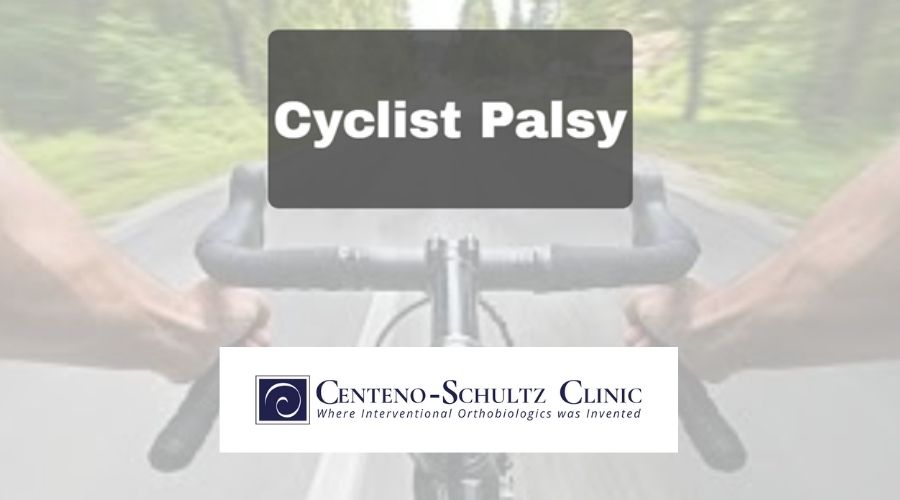Growing up in South Florida, I never knew what it was like to have different seasons – we basically had hot, hotter, and blistering hot! But now being in Colorado for many years, I understand the transitions from winter to spring. It means that its time to put away my snowboard and dust off the golf clubs and grease up the mountain bike!
For many of our patients who have a passion for cycling it also means that the Triple Bypass is right around the corner and it’s time to bump up the training! I had never known about this race until I moved to Colorado. For those who don’t know it, The Triple Bypass is an epic 100+ mile race through the heart of the Colorado Rockies from EVERGREEN TO VAIL, COLORADO!

Today we are going to discuss a syndrome that many of these long-distance cyclists eventually get, what can be done to prevent it, and also treat it if does come up. Condition = Cyclist Palsy (aka Guyon’s Canal Syndrome), and nonsurgical Guyon’s Canal treatment options. Let’s dig in…..
Syndrome of Guyon’s canal is a complex of symptoms of progressive impairment of the ulnar nerve functioning, secondary to chronic, mechanical compression of the nerve within the canal of Guyon. Depending on the location of the lesion within Guyon’s canal, the symptoms may show different forms.
They are similar to the symptoms of the groove for the ulnar nerve, except for the sensory innervation of the dorsum of the hand. This feature is associated with the origin of ramus dorsalis manus, about 5–8 cm proximal from Guyon’s canal. Traditionally the lesions seen in the syndrome of Guyon’s canal are divided following the subdivision proposed by Shea and McClain (Fig. 1).
What Can Cause Guyon’s Canal Syndrome / Cyclist Palsy?
Anything that places excessive pressure on the nerve:
• Chronic or Repetitive Motion (Handlebar Palsy / Cyclist Palsy, vibration — hypothenar hammer syndrome — industrial workers, sportsmen: handball, basketball, tennis, squash, golf, martial arts, break-dancers)
• Diseases of neighboring vessels (aneurysmatic dilation of the ulnar artery, arterio-venous malformations, hemangiomas, thrombosis of the ulnar artery, giant cell arteritis)
• Metabolic diseases (rheumatoid polyarthritis, amyloidosis, sarcoidosis, scleroderma, diabetes)
• Anatomical variations (additional carpal muscles or bones, the presence of piso-hamate arch, fibrosis, protruding or bifid hook of hamate bone)
• Degenerative diseases in the wrist (bone spur/arthritis compressing nerve in Guyon’s canal)
• Idiopathic causatives
• Tumors (ganglion, lipoma, lipo-fibroma, giant cell tumor, schwannoma, neuroma, osteoid osteoma [7–12]
Who Is At Risk For Getting Cyclist Palsy / Guyon’s Canal Syndrome?
Road Bike VS Mountain Biker……Sprint Race VS Endurance Racer….. who is more likely to get cyclist palsy?
A prospective study by Patterson et al in 2003, investigated the incidence of ulnar neuropathy in cyclists. The authors investigated twenty-five cyclists (ages 20–60 years old) randomly chosen for the study, who underwent a 600km bicycle tour over the course of four days. Using a questionnaire and physical examination, ulnar and median nerve function were assessed on day 0 (the day before the ride began) and then re-evaluated on day 4 (within hours of completion of the ride).
70% of the participants experienced some form of neurological symptoms by the end of the ride!
- Motor weakness was experienced by 36%
- The sensory loss was apparent in 10%
- 25% experienced both motor and sensory deficits.
– No difference between experienced riders compared to inexperienced riders regarding symptoms,
– Mountain bikers (9/25) had more sensory loss when compared to individuals who were using road bikes (16/25).
Preventative Measures against Cyclist Palsy
Prevention of ulnar neuropathy and treatment of early symptoms include:
- Proper bike fitting
- Avoidance of excessive or prolonged weight-bearing through the hands,
- Use of padded gloves
- Switching hand positions often on longer rides
Diagnosing Cyclist Palsy
In the clinic, the advancement of technology now allows us to diagnose compressive neuropathies with 98% accuracy based of a detailed physical examination and diagnostic ultrasound imaging…

Several studies have demonstrated that utilizing diagnostic ultrasound to visualize the nerve combined with dynamic test and examination was sensitive >98%
1. The ultrasound features of peripheral nerve defects that were the most important are:
- The diameter or cross-sectional area of the nerve at the site of the visualized pathology;
- nerve echostructure, hyperemia;
- presence of instability in a dynamic US examination;
- pain reaction to nerve compression with the transducer.
Guyon’s Canal Treatment: New Options
Ultrasound doesn’t only allow for diagnosing but advanced ultrasound-guided injection-based therapy are now possible! See Dr. Schultz’s post about advanced, image-guided nerve hydro dissection.
References:
https://ejnpn.springeropen.com/articles/10.1186/s41983-019-0063-1
Depukat P, Mizia E, Kuniewicz M, Bonczar T, Mazur M, Pełka P, Mróz I, Lipski M, Tomaszewski K. Syndrome of canal of Guyon – definition, diagnosis, treatment and complication. Folia Med Cracov. 2015;55(1):17-23. PMID: 26774628.
Brown CK, Stainsby B, Sovak G. Guyon Canal Syndrome: lack of management in a case of unresolved handlebar palsy. J Can Chiropr Assoc. 2014 Dec;58(4):413-20. PMID: 25550666; PMCID: PMC4262815.
Patterson JMM, Jaggars MM, Boyer MI. Ulnar and median nerve palsy in long-distance cyclists. A prospective study. Am J Sports Med. 2003;31(4):585–9.
Ozdemir O, Calisaneller T, Gulsen S, Caner H. Ulnar nerve entrapment in Guyon’s canal due to recurrent carpal tunnel syndrome: case report. Turk Neurosurg. 2011;21(3):435-7. doi: 10.5137/1019-5149.JTN.2959-10.1. PMID: 21845587.
Kowalska B. Assessment of the utility of ultrasonography with high-frequency transducers in the diagnosis of entrapment neuropathies. J Ultrason. 2014 Dec;14(59):371-92. doi: 10.15557/JoU.2014.0039. Epub 2014 Dec 30. PMID: 26674099; PMCID: PMC4579721.
